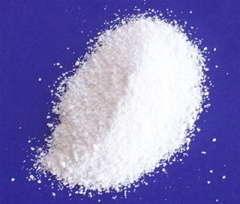Difference between revisions of "Ascorbic Acid"
m (→Description) |
|||
| (9 intermediate revisions by 2 users not shown) | |||
| Line 1: | Line 1: | ||
| + | {{Infobox_Other_organic | ||
| + | | image = Ascorbicacid1.jpg | ||
| + | | origin = Chiefly China | ||
| + | | stowage factor = - | ||
| + | | humidity and moisture = - | ||
| + | | ventilation = - | ||
| + | | risk factors = See text | ||
| + | }} | ||
==Description== | ==Description== | ||
| − | + | Ascorbic acid is a naturally occurring organic compound with antioxidant properties. It is a white solid, but impure samples can appear yellowish. It dissolves well in water to give mildly acidic solutions. Ascorbic acid is one form ("vitamer") of vitamin C. It was originally called L-hexuronic acid, but when it was found to have vitamin C activity in [[animals]] ("vitamin C" being defined as a vitamin activity, not then a specific substance), the suggestion was made to rename L-hexuronic acid. The new name for L-hexuronic acid is derived from a- (meaning "no") and scorbutus (scurvy), the disease caused by a deficiency of vitamin C. Because it is derived from glucose, many animals are able to produce it, but humans require it as part of their nutrition. Other vertebrates lacking the ability to produce ascorbic acid include other primates, guinea pigs, teleost fishes, bats, and birds, all of which require it as a dietary micronutrient (that is, a vitamin). | |
| + | <br><br> | ||
| + | Chemically, there exists a D-ascorbic acid which does not occur in nature. It may be synthesized artificially. It has identical antioxidant properties to L-ascorbic acid, yet has far less vitamin C activity (although not quite zero). This fact is taken as evidence that the antioxidant properties of ascorbic acid are only a small part of its effective vitamin activity. Specifically, L-ascorbate is known to participate in many specific enzyme reactions which require the correct epimer (L-ascorbate and not D-ascorbate). | ||
| + | <br><br> | ||
| + | Ascorbic acid and its sodium, potassium, and calcium salts are commonly used as antioxidant food additives. These compounds are water-soluble and thus cannot protect fats from oxidation: For this purpose, the fat-soluble esters of ascorbic acid with long-chain [[Fatty Acids]] (ascorbyl palmitate or ascorbyl stearate) can be used as food antioxidants. | ||
| + | <br><br> | ||
| − | + | ==Application== | |
| + | Used for colour fixing and as a preservative in food. If moisture is allowed to collect on the drum heads during transit, the crystals may become discoloured, and loose part of their potency due to oxidation. | ||
| + | <br><br> | ||
| + | ==Shipment / Storage== | ||
| + | Generally packed in fibre or multi-wall paper drums. | ||
| + | <br><br> | ||
| + | ==Risk factors== | ||
| + | Risks entailed with shipments of fibre resp. multi-wall paper drums. (moisture, physical/mechanical, defilement/contamination, loss/spillage, etc.)<br><br> | ||
| + | |||
| + | See also: http://www.chemicalland21.com/lifescience/foco/ASCORBIC%20ACID.htm<br><br> | ||
| − | |||
[[Category:Products]] | [[Category:Products]] | ||
| + | [[Category:Oil and chemicals]] | ||
Latest revision as of 15:05, 18 January 2021
| Infobox on Ascorbic Acid | |
|---|---|
| Example of Ascorbic Acid |  |
| Facts | |
| Origin | Chiefly China |
| Stowage factor (in m3/t) | - |
| Humidity / moisture | - |
| Ventilation | - |
| Risk factors | See text |
Ascorbic Acid
Description
Ascorbic acid is a naturally occurring organic compound with antioxidant properties. It is a white solid, but impure samples can appear yellowish. It dissolves well in water to give mildly acidic solutions. Ascorbic acid is one form ("vitamer") of vitamin C. It was originally called L-hexuronic acid, but when it was found to have vitamin C activity in animals ("vitamin C" being defined as a vitamin activity, not then a specific substance), the suggestion was made to rename L-hexuronic acid. The new name for L-hexuronic acid is derived from a- (meaning "no") and scorbutus (scurvy), the disease caused by a deficiency of vitamin C. Because it is derived from glucose, many animals are able to produce it, but humans require it as part of their nutrition. Other vertebrates lacking the ability to produce ascorbic acid include other primates, guinea pigs, teleost fishes, bats, and birds, all of which require it as a dietary micronutrient (that is, a vitamin).
Chemically, there exists a D-ascorbic acid which does not occur in nature. It may be synthesized artificially. It has identical antioxidant properties to L-ascorbic acid, yet has far less vitamin C activity (although not quite zero). This fact is taken as evidence that the antioxidant properties of ascorbic acid are only a small part of its effective vitamin activity. Specifically, L-ascorbate is known to participate in many specific enzyme reactions which require the correct epimer (L-ascorbate and not D-ascorbate).
Ascorbic acid and its sodium, potassium, and calcium salts are commonly used as antioxidant food additives. These compounds are water-soluble and thus cannot protect fats from oxidation: For this purpose, the fat-soluble esters of ascorbic acid with long-chain Fatty Acids (ascorbyl palmitate or ascorbyl stearate) can be used as food antioxidants.
Application
Used for colour fixing and as a preservative in food. If moisture is allowed to collect on the drum heads during transit, the crystals may become discoloured, and loose part of their potency due to oxidation.
Shipment / Storage
Generally packed in fibre or multi-wall paper drums.
Risk factors
Risks entailed with shipments of fibre resp. multi-wall paper drums. (moisture, physical/mechanical, defilement/contamination, loss/spillage, etc.)
See also: http://www.chemicalland21.com/lifescience/foco/ASCORBIC%20ACID.htm











